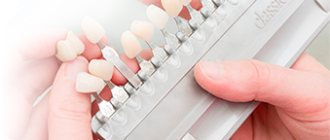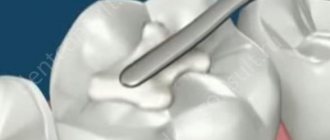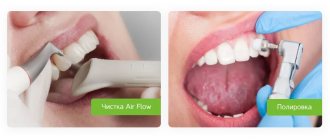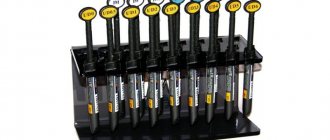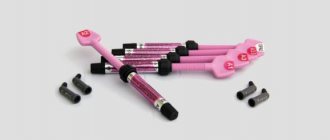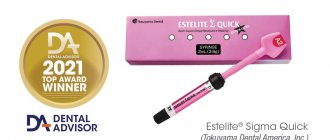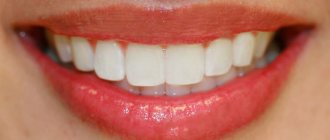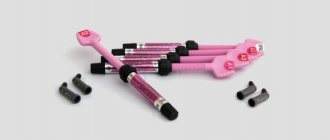Thanks to modern technology, visiting the dentist has become a simple and painless procedure that allows you to monitor your oral health and identify and eliminate various problems. The best material used for filling teeth today is Estelite - a composition that has no analogues in terms of durability, ease of use and reliability.
Estelite – a new word in dental fillings
Quite a few patients will confirm that going to the dentist has always been a very difficult process and few could decide to do it voluntarily.
But the days when filling teeth was a painful procedure are long gone. Today, with the help of introduced innovations, new scientific approaches, high-quality materials and equipment, the prevention and treatment of the oral cavity will be painless and comfortable.
In this article we will talk about the material for filling teeth Estelite.
general information
Japanese scientists have created a special composite solution designed for affected teeth called Estelite Sigma Quick
. This is a special set of elements that have radiopaque properties and can be cured using light radiation.
In addition, this substance looks very aesthetically pleasing and does not stand out at the filling site. The polymerization process is quite fast, so the created product has become popular and used by many dental clinics around the world. Today it is included in the list of the best products among this kind of products.
Components and characteristics
The high level of quality and strength of the presented material is based on the excellent mechanical and physical properties that are inherent in the elements of the composition of this composite mass.
If we talk about filling, then Estelite largely consists of silicon-zirconium and composite filler. Its share in the total mass reaches 82%. The filling material also contains an inorganic compound, which is a spherical submicron filler. Its average particle size reaches only 0.2 microns, and the fractional composition fluctuates at the level of 0.1-0.3 microns. This element is responsible for the level of gloss and slow abrasion of the substance. The monomer base contains bis-glycedimethyl methacrylate (Bis-GMA) and triethylene glycol dimethacrylate.
The higher the degree of filling of the composite substance, the lower the level of polymerization shrinkage.
A feature of the Estelite filling material will be the use of RAP technology or a radical-enhanced polymerization activation system.
Using light radiation emitted by a photopolymerizer (peak wavelength is 470 nm), the time required for the substance to harden is reduced by almost three times compared to other materials traditionally used for filling teeth.
It is thanks to the presence of this unique system in the composition of the Estelite Sigma Quick material that the long service life of the filling is ensured. The substance is presented in syringes and in unit doses (PLT, “PreLoadedTip”).
How it works?
Dentin fragments are instantly filled with the presented preparation. This must be done so that the adhesives penetrate inside at the same level and to demineralize the composition. Only 100% occupancy allows the formation of an integral monomer structure.
In addition, the drug does not depend on whether the working area is dry or wet. The monomer adheres well and holds firmly, which is another positive quality of Estelite.
In order to calculate the material filling boundary with maximum accuracy, a special pigment is used. After the procedure, it easily disappears from the teeth and leaves no traces.
It is also worth paying attention to the fact that this drug significantly reduces the level of enamel sensitivity and promotes good strength. This is what allows it to be one level above traditional composite filling materials. Estelite is also distinguished by its versatility and ease of use.
Warnings
There are certain precautions when working with mixtures:
- The material is squeezed out very carefully and slowly, which will ensure uniform distribution;
- One layer of the mixture cannot exceed a thickness of 2 mm;
- Each layer must be polymerized for 40 seconds;
- When restoring a large cavity, it is necessary to carry out polymerization on all sides.
Types of profiles in dentistry and instructions for using dental instruments.
In this publication you will find a detailed description of the Atatsamit filling material.
Here https://www.vash-dentist.ru/lechenie/zubyi/plombyi/kornevyih-kanalov-metodom-lateralnoy-kondensatsii.html all the most important things about filling the root canal using the lateral condensation method of gutta-percha.
Indications and contraindications
Due to its versatility, this composite can be used in quite a few procedures for the prevention and treatment of dental diseases. Estelite can be used:
- for carrying out the restoration procedure of the frontal zone of the jaw row;
- to eliminate minor external defects from the tooth surface;
- as a base layer;
- in treatment processes using the indirect restoration method;
- to restore artificial tooth fragments;
- as a material for eliminating cracks and diastemas;
- as a component of composite veneers;
- for the prevention and treatment of caries.
The presence of methacrylic monomers in Estelite suggests contraindications for those patients who have an individual intolerance to these substances.
Therefore, before use, you must make sure that this drug will not cause an allergic reaction.
Preparation for use
The process of preparing the oral cavity for appropriate procedures is a necessary and important part of a positive result. Tooth preparation is carried out only in the specified order and includes the following medical procedures:
- Enamel cleaning
– the entire surface of the teeth must be cleaned using a special fluoride-free mass that fits in a rubber container, and then rinsed with water.
- Selecting a color shade
– there is a special shade scale, but to choose the optimal color it is recommended to wait a little, because dry teeth have the same color, while wet teeth are slightly different.
To correctly choose the optimal color option, you should choose the most intense one from those selected.
Attention!
Under no circumstances should professional teeth whitening be performed before these procedures. Otherwise, it may happen that the shade will be quite different after some time. It is also not recommended to use eugenol and its derivatives for protective functions, since then the polymerization process of the presented composite is much worse.
Restoration process step by step
It is recommended to use unidoses in the manner described in the instructions. Before use, an ounce of material is placed in the dispenser, then the cap is removed, which does not allow the material to flow out. The composite is filled directly into the indicated cavity or prepared for application on a special tablet, bringing it to the desired state.
When using a syringe, the following manipulations are performed:
- you need to remove the protective cap;
- turn the handle clockwise;
- place a small amount of mass on a special tablet;
- knead the paste.
Once the material reaches the desired level of consistency, filling and restoration work can be carried out. The paste should be applied in small doses, in layers, so as not to exceed the permissible depth. To guide the dosage, the creators of Estelite have developed a special table.
When the filling process is carried out using the Estelite composite mass, it is prohibited to use other preparations, since the possibility of voids increases and the polymerization process will not proceed properly.
Each layer is polymerized separately, the time specified by the manufacturer. And the surface treatment completes the procedure. The site for restoration work is cleaned and a small cosmetic polishing is carried out using burs with a fine-grained diamond cut.
In order to erase the boundaries between the tooth surface and the filling, the dentist performs a polishing procedure with a multifaceted carbide bur. This does not require water and rotation is minimized.
Palette of material shades
Estelite filling material is available in a very wide range of shades - A1, A2, A3, A3.5, A4, A5, B1, B2, B3, B4, C1, C2, C3, OA1, OA2, OA3, OPA2, BW (created for for filling whitened teeth), CE (for enamel types with increased transparency, cutting edge shade) and WE (white enamel).
The opalescent shades in the product line, which include OA1, OA2 and OA3, are distinguished by a fairly good level of opacity. Thanks to this, Estelite is 100% suitable for blocking the darkness of the oral cavity (this makes it possible to carry out restoration work on cavities of classes 3 and 4).
Opalescent shades are also actively used as dentin shades when restoration procedures are carried out with several different shades in several layers. Shades 4FA1, OA2 and BW are used during restoration work on primary teeth. However, they are practically not used in cases where it is necessary to perform a restoration in which pins and metal structures were used. As well as those teeth whose color has changed significantly. For example, tetracycline teeth.
OPA2 is a color used to hide small enamel stains. The Estelite material can also be used to restore the patient’s opaque teeth.
Important points
When using Estelite filling material, it is important to pay attention to the integrity of the packaging. Since the product is widely known in many countries, there is a possibility of purchasing a fake, which is significantly inferior in quality to the original.
Precautionary measures when using the Estelite nanocomposite:
- use only with medical gloves;
- if the material gets on the mucous membrane, in the eyes, respiratory organs or on clothing, you should immediately rinse the surface;
- The composite can only be used in accordance with the instructions;
- the material is purchased only by professional dentists or clinics that have the appropriate license;
- after using the filling material, all instruments are sterilized;
- Polymerization with the device is carried out only in protective glasses.
Features of using Estelite
- Cleansing.
First, you need to very carefully clean the covering of the tooth with a rubber cup using phosphorus paste, then rinse well with water.
- Selection of shade.
Before installing a rubber dam, you need to choose the optimal tone using a special Estelite palette. You need to choose a color within five minutes, because dry teeth are lighter than when they are wet. One of the key points when choosing is a rich white shade. If there is a choice between two colors, it is better to prefer the white ones (with a more pronounced intensity of whiteness). When working with whitened teeth, you need to select a shade after 10-14 days, because they tend to darken a little.
- Insulation.
Rubber dam is considered the best option for isolating teeth.
- Preparation of the oral cavity.
First, prepare the cavity and clean it with water. Make bevels along the edge of the enamel when preparing anterior teeth (for grades 3, 4 and 5) and soften the edges when preparing lateral teeth (grades 1 and 2). Bevels and smoothing will ensure that the gap between the edge and the restoration disappears, which will give a good aesthetic effect. For strength, it is necessary to choose scalloped bevels. For restorations and composite restorations, a diamond bur can help roughen the coating to improve adhesion. To clean, you can etch the surface with phosphoric acid, rinse with water, dry and apply silane, following the recommendations.
- Pulp protection.
If the cavity is located very close to the pulp, a glass ionomer gasket must be installed. But eugenol-based raw materials should not be used, as this will impair adhesion and hardening.
- Adhesive composition.
The adhesive must be applied according to the manufacturer's instructions. It is especially recommended to use Tokuyama Bond Force, which is considered a one-component, self-etching, light-curing static substance. But it is strictly forbidden to use co-cured adhesive compositions or dual-curing compositions, because they will not give the same adhesive effect that is necessary when using composite raw materials. If you decide to use self-curing adhesive or dual-curing compounds, make sure that they are combined with light-curing raw materials.
- Dosage.
Before using unidose, you need to study the special instructions in the instructions, then you need to move the PLT into a special dispenser, remove the cap, apply the paste into the cavity itself or squeeze it onto a mixing tablet. When using a syringe, you need to remove the cap, turn the handle clockwise, apply the composition to the tablet, and put the cap back on. It is not recommended to apply extra force to the syringe if it has just been taken out of the refrigerator.
- Filling and creation of a contour for restoration.
It is necessary to apply the material to the surface layer by layer, but each layer must be within the specified depth (a special table has been developed for this). It is not recommended to mix Estelite with other types of composite materials or other colors from the Estelite palette. This is done in order to eliminate incomplete polymerization or the appearance of voids.
- Polymerization.
Each layer needs to be polymerized for at least the time indicated in the recommendations (you can check the table). In this case, you need to install the photopolymerizer at a distance of two millimeters from the composition. If you decide to use a composite composition from other manufacturers layer by layer with a cured composite, you must strictly adhere to the recommendations for their use.
- The final stage.
Process and polish the restoration result. At the final stage, use a diamond bur with a minimum grit. To level the boundary between the composite composition and a natural tooth, you need to perform work along the boundaries with a 12-sided bur, but without the use of water and at minimal speeds. It is also recommended to use metal or vinyl abrasive strips to finish the proximal surface. Rubber heads and all other special polishing devices are suitable for polishing.
Precautionary measures
In order to start working with the presented material, you need to comply with all the necessary safety rules specified by the developers. Here is a list of all requirements and contraindications:
- Under no circumstances should the composite be used for purposes other than those specified in the instructions.
- The presented material is used only for medicinal purposes and can only be purchased by a medical institution or persons who have confirmation of the right to conduct dental activities.
- If it is clear that the seal of the drug’s packaging is broken, there are some concerns regarding originality, and there is no special protective seal, then it is extremely undesirable to use such a product.
- The procedure is stopped immediately as soon as the patient shows the first signs of individual intolerance to the drug or its components.
- Since the composite contains methacrylic monomers, you need to be very careful. These substances are classified as allergens and should only be handled with gloves. Also remember that the substance penetrates through latex, so be sure to wash your hands thoroughly after the procedure.
- Do not allow the product to come into contact with exposed areas of the skin. If contact occurs, it is necessary to immediately rinse the affected area and consult a doctor.
- At the end of all procedures, the patient is recommended to rinse the oral cavity. Rinsing can be done several times, using plenty of water.
- Vapors from the drug Estelite should not be inhaled. Also avoid getting the material into the oropharynx. This can lead to very serious consequences.
- After completing the manipulations, the entire instrument must be thoroughly treated with alcohol-containing disinfectants.
- The doctor must carry out the entire work process wearing protective glasses.
Drug release format and cost
Estelite is produced in syringes, its cost ranges from 1500 to 2000 rubles. The kit contains either six test syringes or nine for standard use. For such a kit you will have to pay approximately 12,000-19,000 rubles.
Reviews
Specialists and patients of dental clinics who have had experience working with Herculite composites express their positive opinion and recommend this product for use.
The actual service life of fillings based on Herculite is difficult to estimate, because... they have been used in Russia not so long ago. But aesthetics and quality are trustworthy.
In the comments to this article, you can share your thoughts or reviews about Herculite composites.
If you find an error, please select a piece of text and press Ctrl+Enter.
Tags filling fillings
Did you like the article? stay tuned
Previous article
Subtleties of practical dental restoration using the GlassSpan system
Next article
The mechanism of development of galvanism in the oral cavity and how to avoid the problem
